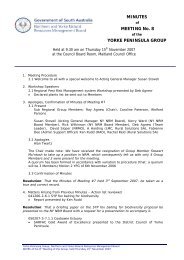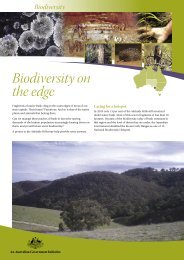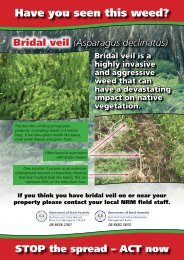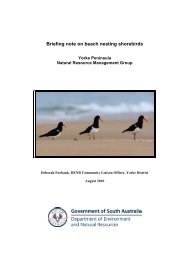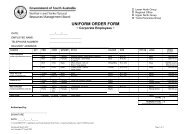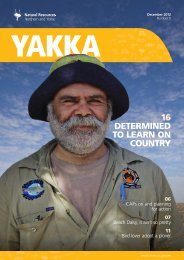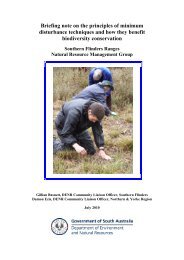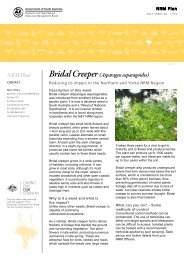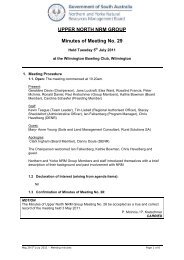Caring for country - Northern and Yorke Natural Resources ...
Caring for country - Northern and Yorke Natural Resources ...
Caring for country - Northern and Yorke Natural Resources ...
Create successful ePaper yourself
Turn your PDF publications into a flip-book with our unique Google optimized e-Paper software.
4coast lines<br />
Diving into marine education<br />
The <strong>for</strong>eshore beside Port Augusta<br />
Yacht Club was recently trans<strong>for</strong>med<br />
into a living classroom when around 130<br />
primary school students came together to<br />
learn more about the marine environment.<br />
The Marine Environment Day provided students<br />
from local schools with insights into the<br />
importance of aquatic biodiversity, tides <strong>and</strong><br />
water movement, <strong>and</strong> threats posed by<br />
marine pests.<br />
Coastal program a shore success<br />
It’s very tempting <strong>for</strong> coastal gardeners to plant<br />
a few cuttings or seedlings that seem to be<br />
doing well in the neighbourhood.<br />
South African daisies <strong>and</strong> numerous species of<br />
succulents are freely obtainable from nearby<br />
gardens <strong>and</strong> s<strong>and</strong>hills <strong>and</strong> they can look good<br />
within a couple of months.<br />
Isn’t this better than driving to a nursery to buy<br />
native seedlings that may also take longer to<br />
look as good?<br />
“Not so,” says David Sloper, NRM officer<br />
with <strong>Northern</strong> <strong>and</strong> <strong>Yorke</strong> <strong>Natural</strong> <strong>Resources</strong><br />
Management Board, who has just helped<br />
rewrite an excellent guide, Coastal Gardens:<br />
A planting guide <strong>for</strong> the <strong>Northern</strong> <strong>and</strong> <strong>Yorke</strong><br />
Coastal Region.<br />
“Imported weeds such as South African<br />
daisies <strong>and</strong> succulents have no natural pests or<br />
diseases to slow them down, so when they get<br />
established they take over – especially when<br />
they jump the fence,” Mr Sloper said.<br />
Launched by Marine Advisory Committee<br />
chairman Peter Solomon, the event was<br />
organised by the <strong>Northern</strong> <strong>and</strong> <strong>Yorke</strong> NRM<br />
Board’s Upper North team <strong>and</strong> supported by<br />
the Port Augusta Marine Advisory Committee,<br />
Port Augusta Council <strong>and</strong> the <strong>for</strong>mer<br />
Department of Environment <strong>and</strong> Heritage.<br />
The Board’s Upper North team leader Kevin<br />
Teague, <strong>and</strong> administration officer Stacey<br />
Shackle<strong>for</strong>d, said superb weather allowed the<br />
students to enjoy a day out of their normal<br />
classroom <strong>and</strong> gain a greater underst<strong>and</strong>ing<br />
of the importance of caring <strong>for</strong> the natural<br />
environment.<br />
“The result of these weeds taking over is that<br />
local native species are crowded out <strong>and</strong> that<br />
means native birds, lizards <strong>and</strong> butterflies find<br />
it harder to find the local foods <strong>and</strong> shelter<br />
they need.”<br />
To encourage gardeners along the coast from<br />
Port Wakefield to Port Augusta, the planting<br />
guide will be available from NYNRM Board <strong>and</strong><br />
council offices <strong>and</strong> from local nurseries.<br />
The booklet will be launched in Wallaroo on<br />
21 October by Hon Paul Caica, Minister <strong>for</strong><br />
Environment <strong>and</strong> Conservation, in an official<br />
ceremony at the Wallaroo North Beach coastal<br />
plant demonstration garden.<br />
The coastal garden was jointly developed by the<br />
Copper Coast Council <strong>and</strong> the NYNRM Board,<br />
<strong>and</strong> will also be launched on the day - the first<br />
of at least nine coastal demonstration gardens<br />
planned <strong>for</strong> the region.<br />
The gardens are designed to show coastal<br />
residents a range of up to 20 local plant species<br />
that can be safely grown along our coastline.<br />
The species have been selected <strong>for</strong> their<br />
low mature height, <strong>for</strong>m, flowering <strong>and</strong><br />
foliage colour.<br />
Sites at Port Clinton, Port Vincent <strong>and</strong> Port<br />
Kevin said it was very much a h<strong>and</strong>s on,<br />
interactive experience <strong>for</strong> the students with<br />
highlights including a presentation on coast<br />
<strong>and</strong> marine pests, <strong>and</strong> camera vision of<br />
underwater life.<br />
Children also took part in a mangrove <strong>for</strong>est<br />
walk, a guided tour of the Port Augusta<br />
Aquatic Centre, <strong>and</strong> an inspection of the Coast<br />
Guard shed, boat <strong>and</strong> equipment.<br />
Above: Port Augusta West Primary School<br />
students on board a coast guard boat.<br />
Photo Jessie Nicolson<br />
Broughton will be completed shortly with<br />
planning well underway <strong>for</strong> sites at Coobowie,<br />
Marion Bay, Point Turton, Port Victoria <strong>and</strong> Port<br />
Hughes.<br />
It is hoped that sites can also be established<br />
in conjunction with local government in<br />
Port Wakefield, Port Augusta <strong>and</strong> the Port<br />
Pirie region.<br />
Most of the gardens have been part-funded by<br />
the NYNRM Board under its Community Grants<br />
program.<br />
The launch will be followed by a series of free<br />
community workshops along the coast from<br />
Port Wakefield to Port Augusta.<br />
The NYNRM Board is already working closely<br />
with local nurseries to ensure that they are<br />
familiar with the planting guide <strong>and</strong> that<br />
stocks of recommended plants are available in<br />
the region.<br />
The planting guide will also be available on line<br />
through the <strong>Northern</strong> <strong>and</strong> <strong>Yorke</strong> NRM Board<br />
website at www.nynrm.sa.gov.au<br />
Beach access<br />
on track<br />
A motor vehicle access management<br />
strategy has been developed <strong>for</strong> coastal<br />
councils in the <strong>Northern</strong> <strong>and</strong> <strong>Yorke</strong> region.<br />
The strategy to control unauthorised vehicle<br />
access has been adopted by each of the seven<br />
Councils represented in the Coastal Councils<br />
Network (CCN) – Wakefield, <strong>Yorke</strong> Peninsula,<br />
Copper Coast, Barunga West, Port Pirie, Mount<br />
Remarkable <strong>and</strong> Port Augusta.<br />
A coastal councils signage guide has also been<br />
developed to provide a consistent management<br />
approach across each of the Local Government<br />
areas.<br />
These outcomes follow a three-year CCN<br />
research project managed through the Central<br />
Local Government Region of Councils with<br />
funding support from the <strong>Northern</strong> <strong>and</strong> <strong>Yorke</strong><br />
NRM Board <strong>and</strong> the Australian Government’s<br />
Envirofund.<br />
Unauthorised access by motor vehicles –<br />
including two <strong>and</strong> four-wheel drive vehicles,<br />
trail <strong>and</strong> quad bikes <strong>and</strong> specialised vehicles<br />
such as dune buggies – was identified as a<br />
major threat to environmental, cultural, social<br />
<strong>and</strong> economic assets <strong>and</strong> values along the<br />
region’s shoreline.<br />
Anita Crisp, executive officer of the Central<br />
Local Government Region of Councils, said<br />
managing vehicle access to key coastal<br />
locations required both a consistent<br />
methodology <strong>and</strong> recognition of unique<br />
conservation values <strong>and</strong> resources within each<br />
Council area.<br />
“Excess access roads will be considered <strong>for</strong><br />
closure,” she said. “Other key actions will<br />
include rationalisation of in<strong>for</strong>mal access tracks<br />
through coastal vegetation <strong>and</strong> clearly marked<br />
preferred tracks. Foreshore parking facilities will<br />
be improved at areas of preferred<br />
coastal access.”<br />
Ms Crisp, who is also the Local Government<br />
representative on the <strong>Northern</strong> <strong>and</strong> <strong>Yorke</strong><br />
NRM Board, said other actions under the<br />
management strategy include:<br />
• speed restriction zones at beaches identified<br />
<strong>for</strong> motor vehicle access;<br />
• prohibiting driving on vegetated dune areas;<br />
• improving safety <strong>and</strong> awareness through<br />
signage <strong>and</strong> education programs; <strong>and</strong><br />
• a requirement that all motor vehicles<br />
accessing coastal areas are to be registered<br />
<strong>and</strong> operated by licensed drivers.<br />
The actions plans will be implemented<br />
progressively over a five-year period.<br />
“This will require a process of engagement<br />
with four-wheel driver owners, trail bike riders,<br />
Aboriginal groups, local residents, tourism<br />
operators <strong>and</strong> others who have an interest in<br />
vehicle access to beaches <strong>and</strong> coastal reserves,”<br />
Ms Crisp said.<br />
<strong>Northern</strong> <strong>and</strong> <strong>Yorke</strong> <strong>Natural</strong> <strong>Resources</strong> Management Board 25




